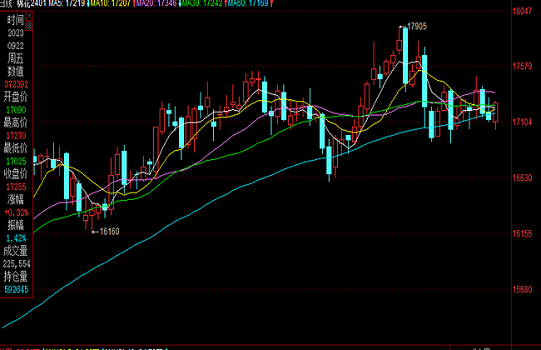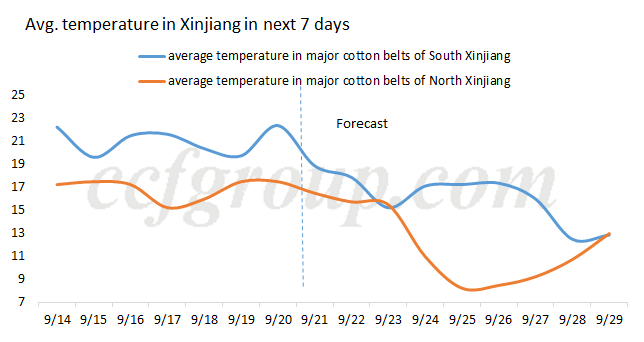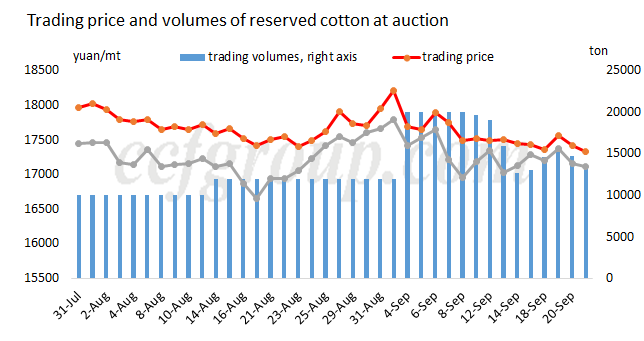Bulls and bears cover on ZCE cotton, how will the market fare?
Since Sep, ZCE cotton futures market has fluctuated at high level after a large fall. In early to mid-Sep, the longs attempted to push the market higher, aiming to break through resistance levels, but all attempts ended in failure. Recently, there have been increasing factors affecting the supply side of the cotton market, leading to significant divergence between longs and shorts. The cotton prices are difficult to drop below 17,000yuan/mt and has been fluctuating within the range of 17,000-17,500yuan/mt. This article will interpret the key contradictions between longs and shorts recently.

Firstly, since early Sep, temperature in some cotton belts of Xinjiang dropped obviously. The low temperature in some regions of North Xinjiang have led to poor defoliation in local cotton fields. In the next seven days, both South and North Xinjiang will experience varying degrees of cooling. It is noteworthy that from Sep 23rd to around Sep 26th, there will be a sudden drop of 6 degrees Celsius in places like Wusu and Bole in North Xinjiang. Therefore, concerns about the maturity and quality of cotton persist in the market. Prior to the arrivals of new cotton, this cooling weather may provide some support to cotton prices.

In Sep, there have been some policy measures implemented, with clear objectives aimed at suppressing cotton futures and spot prices and curbing market speculation. Starting from Sep 4th, the daily selling volume of reserve cotton increased to 20,000 tons. Initially, the volume was mostly around 10,000-12,000 tons, and most market participants believed that 10,000-12,000 tons might become the new norm in the future. The increase to 20,000 tons per day has significantly expanded the supply of spot cotton, catching many market participants off guard. In addition, there are possibilities that the state cotton reserves sales will be prolonged and the additional 750kt of sliding-scale duty quotas are released successively, which has led to the increasing imported cotton in Sep and narrowed price advantage of reserved cotton. The enthusiasm of spinning mills for bidding on reserve cotton has cooled down, and the transaction rate has decreased. Conversely, spinning mills have increased their inquiries for prompt and nearby shipments. The continuous implementation of a series of policies demonstrates the determination of decision-makers to stabilize domestic cotton prices and promote cotton imports to balance the price difference between domestic and foreign markets.

Next, the purchase prices of seed cotton are high. Previously, the purchase prices of seed cotton for wadding were mostly at 9.1-9.3yuan/kg, while recently, the prices were mainly around 9.35yuan/kg in Bachu of South Xinjiang with ginning yield of 42%. Seed cotton has not arrived on the market intensively, and the price direction is still not clear. Currently, cotton seed prices slip to around 3.1yuan/kg. Selling prices of cotton for wadding are around 19,400-19,600yuan/mt gross weight, and the orders are limited later. Though ginners' expectation on seed cotton procurement competition weakens somewhat with the release of policies, the speculative sentiment on 2023/24 seed cotton prices and high cotton costs continues.
Viewed from the downstream consumption side, Sep is the traditional peak season for cotton textile industry, but there is no obvious improvement this year. Recently, trading volumes in Nantong reduce somewhat and Guangdong market also has no positive performance. In addition, with the release of series of cotton polies and thin downstream demand, bullish sentiment weakens somewhat and with unfavorable orders, fabric mills show lower buying interests.
Overall, the cotton market lacks significant driving factors recently, with intense speculation from both longs and shorts. There has been an increase in disruptive factors on the supply side, including a decrease in transaction rates despite the higher selling volumes of reserved cotton, a rise in cotton imports, and the possibility of lower-than-expected prices for new seed cotton. On the demand side, the market is not favorable in traditional peak season. In summary, cotton prices may fluctuate widely in the short term, and it is important to pay attention to the impact of machine-picked seed cotton prices and macroeconomic conditions.
- Top keywords
- Cotton Price
- Cotton Futures Price
- Cotton Futures
- CZCE
- PTA Futures Price
- Chemical Fiber
- Polyester Prices
- Wool price
- PTA Futures
- Shengze Silk
- China
- Yarn Price
- price
- China Textile City
- Fibre Price
- Benzene Price
- Cotton
- Index
- Cotton Index
- PTA
- fabric price
- NYMEX
- Top 10
- textile industry
- Spot Cotton
- Cotton Yarn
- Polyester Price
- Futures
- PTA Price
- cotton yarn price

